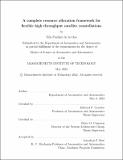| dc.description.abstract | The past few years have been a witness for the rise of the new era of satellite communications. The interest for providing broadband access from space has reached levels that remind of those in the late 90s with Iridium and Globalstar among others. The novel mega-constellation designs will rely on thousands of highly capable satellites to provide service to the ever-growing communications market. Nevertheless, the new payload flexibilities and the larger space segment involve a level of complexity and dimensionality that this sector has not seen before. While manual allocation of resources was feasible and efficient in early stages of this industry, it becomes unfeasible under the new conditions. To exploit the capabilities of the new spacecrafts to its full potential, new automatic and optimized tools for the Resource Allocation (RA) problem in the context of satellite communications need to be developed.
While individual tools and methods for the specific sub-problems have been proposed during these last years, most approaches fail to address the interactions between different sub-problems, and those who do rely on simplified assumptions that do not capture the reality of modern operations. To close this gap, this Thesis proposes an adaptive framework to solve the long-horizon RA problem under high dimensionality conditions for highly flexible satellite constellations. The proposed framework uses a divide-and-conquer approach where the RA problem is decomposed into different sub-problems, then solved via state-of-the-art optimization techniques, and integrated back to obtain a valid, feasible, and efficient solution for the long-horizon RA problem. The performance of this framework is then analyzed using different user distributions, model parameters, and solution algorithms to understand the capabilities and robustness of the obtained solutions, as well as the sensitivity to the different variables.
The executed analyses prove the validity and effectiveness of the framework to deal with the incumbent problem. Specifically, the proposed method and algorithms prove to be robust against a variety of user distributions and model parameters, being always able to obtain a feasible plan. In addition, the tests performed in this work demonstrate that the state-of-the-art algorithms significantly outperform simple techniques, being able to multiply the capacity of the constellation by 4 with the same payload characteristics, while reducing to a third the power consumption. Furthermore, the sensitivity tests prove that optimized solutions are able to achieve improved coverage even with limited hardware compared to heuristic techniques. | |
